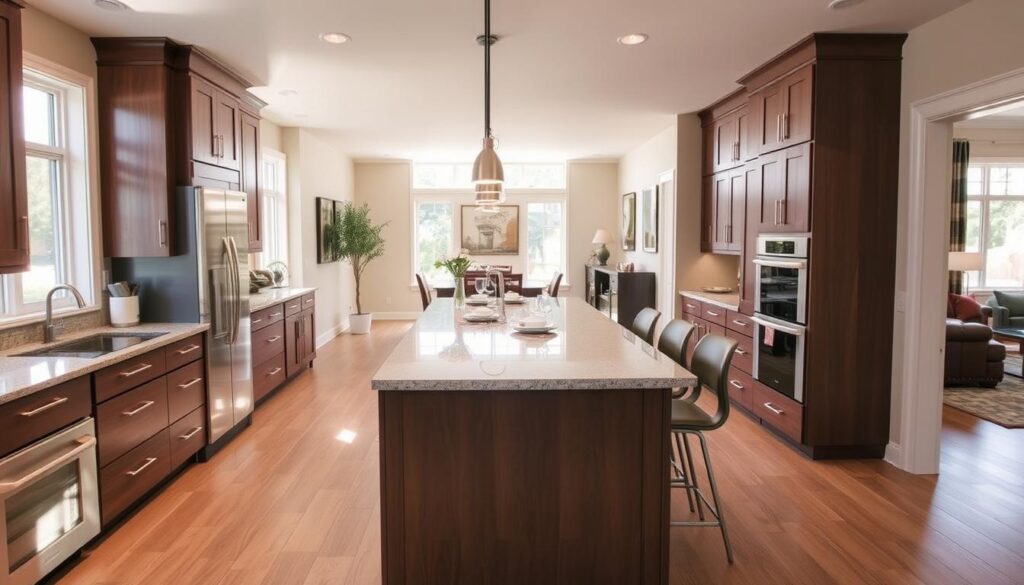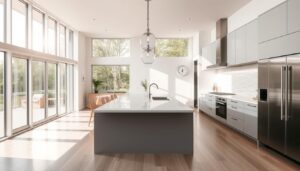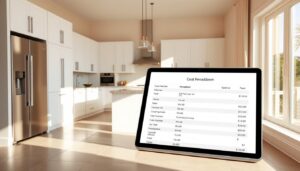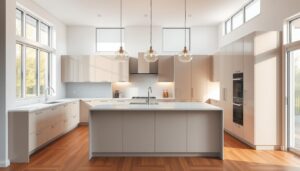Updating your cooking space is an exciting project, but budgeting wisely is essential. This guide provides the latest figures for homeowners considering a refresh in the coming year.
Prices vary significantly based on layout, material selections, and where you live. Recent RICS research shows costs rising across all UK regions, making careful planning more important than ever.
Beyond the obvious expenses, remember to factor in temporary disruptions. We’ll explore smart ways to minimise hassle while achieving the kitchen you’ve always wanted.
Key Takeaways
- Current pricing reflects 2024 market conditions
- Location significantly impacts overall expenditure
- Project timelines typically span several weeks
- Unforeseen expenses often arise during works
- Strategic choices can reduce final outlay
Introduction to Kitchen Renovation Costs in the UK
Investing in your home’s heart demands balancing aspirations with practicality. A kitchen renovation isn’t just about aesthetics—it’s a transformative process that impacts daily life. From meal prep to family gatherings, this space sets the tone for your home.
Why does this project feel overwhelming? Unlike other rooms, kitchens blend plumbing, electrical work, and design. A study by Kitchen Magic revealed homeowners saved 50% by replacing cabinet doors instead of overhauling the entire space. Smart choices like these keep your budget intact.
The psychological effects are real. Living without a functional cooking area disrupts routines. Most projects span 2–6 weeks, depending on scale. Smaller updates (like worktop replacements) may take days, while full refits require patience.
| Project Scale | Timeline | Labour Cost (%) |
|---|---|---|
| Cosmetic Updates | 3–7 days | 25% |
| Mid-Range Refresh | 2–4 weeks | 33% |
| Full Renovation | 4–8 weeks | 40%+ |
Don’t overlook inconvenience costs. Dust, noise, and limited access add stress. Companies like Kitchen Magic specialise in minimising disruption—think sealed work zones and phased timelines.
For those considering a full overhaul, Checkatrade notes £35k as the upper benchmark. Whether you’re making a savvy investment or prioritising functionality, planning is key to success.
Average Kitchen Renovation Cost in 2024
Planning a refresh for your cooking space? Understanding the financial landscape helps set realistic expectations. Current pricing reflects material availability, labour demands, and regional variations across the UK.
Industry experts categorise projects into three tiers. Each offers distinct advantages depending on your priorities—whether functionality, aesthetics, or long-term value.
Budget-Friendly Renovations: £4,000–£8,000
For those watching the purse strings, pre-fabricated units and laminate worktops deliver smart savings. A small kitchen can feel brand-new with:
- Refaced cabinet doors instead of full replacements
- Standard appliances from reputable brands
- Vinyl flooring or refreshed existing tiles
Checkatrade notes this range typically covers 10–15 square metres. Clever choices like open shelving instead of upper cabinets stretch budgets further.
Mid-Range Renovations: £8,000–£15,000
This sweet spot balances quality and affordability. Expect:
- Semi-custom cabinetry with soft-close mechanisms
- Quartz or solid-surface worktops
- Integrated appliances from mid-tier manufacturers
Labour accounts for roughly 35% here. Regional differences matter—London tradespeople charge 15–20% more than Northern counterparts.
High-End Bespoke Kitchens: £15,000–£35,000+
For a full kitchen renovation with luxury finishes, bespoke solutions dominate. Features include:
- Handmade, painted-to-order cabinetry
- Natural stone surfaces like marble or granite
- Professional-grade appliances
“Bespoke projects often cost £2,500–£4,000 per square metre, but add significant property value.”
Remember, smaller spaces can achieve premium looks within lower brackets through strategic material selection and layout efficiency.
Key Factors Influencing Your Kitchen Renovation Cost
Transforming your culinary space involves multiple financial considerations beyond surface-level changes. Whether you’re aiming for a modest update or a complete overhaul, these elements will shape your budget.
Kitchen Size and Layout Complexity
The size of your space directly correlates with material quantities and labour hours. Compact galley kitchens often cost 30% less than open-plan designs requiring structural changes.
Consider these spatial challenges:
- Plumbing relocations add £800–£2,000 if moving sinks or dishwashers
- Electrical rewiring costs £1,200–£3,500 for modern safety standards
- Load-bearing wall removals demand £1,500+ for steel supports
Choice of Materials: Cabinets, Worktops, and Flooring
Cabinets consume 30–50% of budgets according to industry analysts. Options range from:
- Flat-pack units (£1,200–£3,500)
- Semi-custom designs (£4,000–£8,000)
- Bespoke handmade cabinets (£10,000+)
Worktops show dramatic price variations:
- Laminate: £80–£120 per linear metre
- Granite: £300–£600 per linear metre
- Marble: £900–£1,500 per linear metre
Appliances: Budget vs. Luxury Models
Your appliances selection creates lasting operational costs. Energy-efficient models may cost more upfront but save £100+ annually on bills.
Comparative pricing:
- Bosch integrated fridge: £700–£1,200
- Miele premium range: £2,500–£5,000
- Induction hobs vary from £400 (basic) to £3,000 (professional)
“Refacing cabinet doors instead of full replacements can slash costs by 60% while achieving similar visual impact.”
Labour Costs: What to Expect for Installation and Fitting
Labour expenses often surprise homeowners during a kitchen update. Unlike material costs, tradespeople’s fees fluctuate based on expertise, location, and project complexity. Allocating 30–50% of your budget to installation ensures skilled handling of electrical, plumbing, and cabinetry work.
Daily Rates for Tradesmen
UK tradesmen typically charge by the day or project. Here’s a breakdown:
| Trade | Daily Rate | Key Tasks |
|---|---|---|
| Carpenter | £125 | Cabinet fitting, shelving |
| Electrician | £125–£150 | Rewiring, lighting |
| Plumber | £130–£170 | Pipework, appliance hookups |
London rates exceed Northern England’s by 15–20%. Gas-safe registered professionals command higher fees due to certification requirements.
Professional Design Services: Are They Worth It?
Hiring a designer (£1,000–£2,500) adds quality and efficiency. Benefits include:
- Space optimisation: Expert layouts maximise functionality.
- Material guidance: Avoid costly mismatches or overordering.
- Project coordination: Streamline multi-trader schedules.
“A designer’s fee often pays for itself by preventing layout errors that cost £3k+ to rectify.”
Companies like Kitchen Magic offer all-inclusive service packages, blending design and fitting for predictable pricing.
Hidden costs lurk in waste removal (£200–£500), overtime, or delays from material shortages. Always include a 10% contingency for unforeseen labour extensions.
Breaking Down the Costs: Cabinets, Worktops, and More
Cabinets and worktops form the backbone of any functional cooking space. These elements determine both visual appeal and daily practicality. Understanding material options helps balance initial expenditure with long-term satisfaction.
Stock vs. Semi-Custom vs. Bespoke Cabinets
Kitchen units vary dramatically in quality and price. Here’s what distinguishes the three main types:
- Stock cabinets (£50–£200/m²): Pre-made sizes with limited finishes. Ideal for tight budgets but offer minimal configuration.
- Semi-custom (£200–£400/m²): Adjustable dimensions with upgraded hardware. Soft-close hinges and full-extension drawers add functionality.
- Bespoke (£400–£1,100/m²): Handcrafted to exact specifications. Uses premium materials like solid oak with dovetail joinery.
Vertical cabinetry maximises storage in compact spaces. Tall larder units provide 30% more capacity than base cabinets alone.
Popular Worktop Materials and Their Price Ranges
Your kitchen worktops endure daily wear while setting the style tone. Consider these options:
| Material | Cost per square metre | Lifespan |
|---|---|---|
| Laminate | £80–£150 | 10–15 years |
| Quartz | £250–£600 | 25+ years |
| Granite | £400–£2,500 | Lifetime |
Solid surfaces like quartz resist stains better than natural stone. For budget-conscious homeowners, laminate now offers convincing wood and stone effects.
“Upgrading cabinet handles and drawer runners can refresh kitchen units for under £200, delaying full replacement costs.”
Second-life solutions gain popularity. Painting existing frames and replacing doors saves 60–70% versus new installations. Glass-front upper cabinets maintain openness while concealing clutter.
How Much Does a Small Kitchen Renovation Cost?
Compact kitchens present unique challenges and opportunities for homeowners. Recent industry data shows refresh projects typically range between £5,000 and £11,500, with labour accounting for 20-30% of expenditure.
Maximising every inch of space is crucial in tighter layouts. Built-in appliances like 24-inch dishwashers save 15-20% compared to standard models while maintaining functionality. Vertical solutions from floor-to-ceiling cabinets to magnetic knife strips create storage without sacrificing floor area.
The cost kitchen professionals quote often reflects material choices for smaller surfaces. Laminate worktops with stone effects offer premium look at half the price of natural materials. Glass splashbacks visually expand the area while being easier to clean than tiles.
Clever options include fold-down dining tables that tuck away when unused. Under-cabinet lighting draws the eye upward, making ceilings appear higher. One London homeowner transformed a 6m² galley for £6,800 using these strategies—keeping plumbing unchanged saved £1,200 alone.
“Smaller kitchens often deliver better ROI per square metre when selling, as buyers appreciate intelligent space planning.”
Open shelving instead of upper cabinets cuts costs by 30% while maintaining accessibility. For those keeping existing layouts, refacing doors and updating hardware provides fresh style without structural work. Every decision should balance immediate savings with long-term practicality.
Regional Variations in Kitchen Renovation Prices
Your postcode can influence quotes more than you might expect. Labour and material costs shift noticeably across the UK, making location a key price determinant.
Londoners face the steepest bills, with tradesmen charging 20–25% more than in the Midlands. Remote areas add logistical hurdles—transporting materials to Scotland’s Highlands can inflate budgets by 10–15%.
| Region | Labour Cost Index | Material Surcharge |
|---|---|---|
| London | 1.25x | 5–10% |
| Midlands | 1.0x | 0–3% |
| Northern Ireland | 0.9x | 7–12% |
Urban projects benefit from tighter contractor networks. Rural homeowners often wait weeks for available service providers. One Yorkshire family saved 15% by hiring fitters from a neighbouring district instead of waiting for local availability.
Smart strategies to offset regional disparities:
- Negotiate bulk discounts with nearby suppliers for shared deliveries
- Time your project offseason when tradesmen have fewer bookings
- Check council permit fees—some charge £150 vs others at £300+
“Rural renovations demand flexible timelines, but local tradesmen often offer personalised attention that city firms can’t match.”
Remember, renovation costs in coastal towns may include weather-proofing materials. Always request location-specific quotes to avoid surprises.
Hidden Costs to Watch Out For
Renovating your cooking area involves more than meets the eye. Beyond the obvious expenses, several hidden costs can impact your budget and timeline. Being aware of these helps prevent financial surprises during the process.
Structural Changes and Plumbing Adjustments
Older properties often reveal unexpected issues once work begins. These can significantly increase your final bill:
- Asbestos removal: £500–£2,000 if found in older flooring or insulation
- Damp proofing: £800–£3,000 depending on wall size and treatment type
- Plumbing relocations: £1,200+ if moving sinks or dishwashers to new positions
Terraced homes may require party wall agreements (£700–£1,500). Always factor in building regulation compliance fees (£150–£300) for structural alterations.
Waste Removal and Unexpected Delays
Demolition generates more waste than many anticipate. Professional clearance costs £200–£500, while skip hire averages £250–£400 weekly.
Weather disruptions can extend projects by days or weeks. Heavy rain delays deliveries, while cold temperatures affect material installations. Setting up a temporary kitchen (microwave, portable hob) adds £150–£300 to budgets.
“A 10–15% contingency fund covers 90% of unforeseen expenses in typical renovations.”
Other often-overlooked costs include:
- Storage fees for new appliances if delivery precedes installation readiness
- Overtime charges when projects exceed agreed timelines
- Specialist tool rentals for complex installations
Planning for these possibilities ensures your project stays on track financially. Always discuss potential extra charges with contractors before signing agreements.
6 Ways to Save Money on Your Kitchen Renovation
Strategic choices can dramatically reduce your renovation expenditure. From cabinet solutions to smart shopping tactics, these approaches maintain quality while keeping costs manageable.
Refacing Cabinets Instead of Replacing
New cabinet doors and drawer fronts can transform your space for 30-70% less than full replacements. Online retailers offer custom sizing at 50% savings compared to showroom prices.
Consider these options:
- Paint existing frames for £15-£25 per cabinet
- Replace just the visible panels with matching veneers
- Update handles and knobs for instant visual impact
Keeping Plumbing and Electrical Layouts Unchanged
Moving pipes and wiring accounts for 20-35% of labour costs. One Bristol homeowner saved £2,800 by maintaining their existing kitchen footprint.
Work with your current layout by:
- Placing new appliances in original locations
- Using flexible hoses for minor sink adjustments
- Installing surface-mounted lighting instead of rewiring
Shopping for Appliances During Sales
Major retailers discount last year’s models by 30-50% during January and July. Sign up for stock alerts to catch clearance deals on display items.
Timing tips:
- New models typically launch in March and September
- Black Friday often includes package deals
- End-of-financial-year sales (March/April) offer bargains
Mixing High-End and Budget Materials
Create a luxury look without the price tag by strategically combining materials. Spend on visible surfaces like worktops, then choose affordable options for less noticeable areas.
Effective combinations:
- Quartz worktops with laminate breakfast bars
- Solid wood island fronts with painted MDF base units
- Glass splashbacks behind standard ceramic hobs
DIY Demolition and Painting
Careful self-removal of old units can save £500-£1,200 in labour. Painting walls yourself avoids £25-£40 per hour decorator fees.
Safety first:
- Turn off water and electricity before starting
- Wear protective gear when handling old materials
- Hire a skip for £200-£400 to manage waste
Comparing Multiple Quotes
Obtain at least three detailed estimates to identify fair pricing. Checkatrade data shows homeowners save 15-25% through thorough comparisons.
Negotiation tactics:
- Ask for breakdowns of material vs labour costs
- Request references from recent clients
- Consider slightly off-peak scheduling for better rates
“Combining these strategies helped one Manchester family achieve their dream kitchen for 40% under budget.”
Bespoke vs. Flat-Pack Kitchens: Cost Comparison
The cabinet debate pits convenience against personalisation in modern kitchen design. While flat-pack solutions offer immediate availability, custom creations provide tailored functionality. Your choice impacts timelines, price points, and long-term satisfaction.
Lead times vary dramatically between options. Flat-pack kitchen units typically arrive within 4 weeks, ready for self-assembly. Bespoke designs require 12+ weeks for measurements, manufacturing, and quality checks. One Surrey homeowner waited 14 weeks for hand-painted cabinetry but gained 23% more storage through custom sizing.
Durability often justifies the wait for a new kitchen. Solid wood bespoke units last 25+ years with proper care, while particleboard flat-packs average 10-15 years. Resale values reflect this – estate agents note 7-12% higher valuations for properties with custom cabinetry.
Customisation limits define each approach. Flat-pack systems offer:
- Standard sizes with limited adjustment
- Predetermined colour options
- Fixed internal configurations
Hybrid solutions bridge both worlds. Combining flat-pack carcasses with custom fronts saves 30-40% versus full bespoke. A London designer recently created a dream kitchen this way, spending £8,500 instead of £14,000.
“Bespoke kitchens require professional fitters (£150/day), while competent DIYers can assemble flat-packs with basic tools.”
Consider your investment horizon. Short-term homeowners may prefer flat-pack affordability, while those settling long-term often benefit from custom quality. Always request samples – touching materials reveals quality differences photos can’t show.
How Long Does a Kitchen Renovation Take?
Project timelines vary more than most anticipate when refreshing their culinary hub. The average process spans 3–6 weeks, but intricate designs or supply delays can extend this. Proper scheduling ensures tradespeople don’t trip over each other’s work.
- Week 1: Demolition and structural changes
- Weeks 2–3: First fix (plumbing/electrical rough-ins)
- Week 4: Cabinet and appliance installation
- Final days: Finishing touches and inspections
Critical path items dictate overall duration. Cabinet lead time often becomes the bottleneck—bespoke units take 12+ weeks versus 4 for flat-pack. One Surrey family saved 18 days by choosing semi-custom options when their designer’s preferred supplier faced Brexit-related delays.
Weather disrupts exterior work. Winter projects may stall if:
- Delivery trucks can’t navigate icy roads
- Low temperatures prevent tile adhesive from curing
- High humidity warps unfinished wood
“Rush jobs attract 20–30% premiums as tradespeople reshuffle other commitments. Planning six months ahead avoids these fees.”
Temporary kitchen setups typically last 4–8 weeks. Essential items include:
- Microwave and slow cooker for basic meals
- Portable induction hob (£60–£120)
- Collapsible washing-up station
Remember, the final 10% of work often takes 30% of the time. Snagging issues like misaligned doors or grout touch-ups require patience. Build in a buffer week before hosting that first dinner party.
Adding Value to Your Home with a Kitchen Renovation
Property experts consistently rank kitchens as the most valuable room to upgrade. RICS valuation guidelines show a quality culinary space can deliver 5-15% increases in home valuations, outperforming bathroom or loft conversions.

| Project Scale | Average Cost | Value Added | ROI % |
|---|---|---|---|
| Cosmetic Refresh | £4,000–£8,000 | £5,000–£9,000 | 112% |
| Mid-Range | £12,000–£18,000 | £15,000–£22,000 | 122% |
| Bespoke Luxury | £25,000+ | £30,000–£40,000 | 120% |
First Source research highlights buyer priorities. Integrated appliances outrank trendy finishes, while storage solutions matter more than island breakfast bars. Neutral palettes appeal to 73% of purchasers versus bold colours at 27%.
Energy efficiency certifications boost appeal. A-rated appliances and LED lighting can add 2-3% to valuations. One Leeds homeowner saw £25k added value from a £15k renovation by focusing on:
- Underfloor heating with smart controls
- Recycled glass worktops
- Concealed charging stations
“Over-improving risks pricing your property beyond neighbourhood norms. In postcodes with £300k averages, £50k kitchens rarely recoup full costs.”
Creating your dream kitchen requires balancing personal taste with resale considerations. Professional valuations help gauge appropriate investment levels. Remember, timeless designs outlast fleeting trends in the property market.
Conclusion: Planning Your Dream Kitchen Within Budget
Creating your ideal culinary space requires smart planning and realistic budgeting. By comparing multiple quotes and prioritising phased updates, you can manage the final cost without compromising quality.
Digital tools like cost calculators help track expenses, while a 10% contingency fund covers surprises. Always verify contractor credentials before committing—saving pennies now may cost pounds later.
Your dream kitchen should balance aesthetics with practicality. Regular maintenance preserves your investment, ensuring years of enjoyment. With careful planning, even ambitious projects stay within reach.
FAQ
What’s the typical price range for a budget-friendly kitchen upgrade?
For a simple refresh, expect to spend between £4,000 and £8,000. This usually includes basic units, laminate worktops, and standard appliances.
How does kitchen size affect the final price?
Larger spaces require more materials and labour, increasing costs. Smaller kitchens often stay within lower budgets unless premium finishes are chosen.
Are bespoke kitchens significantly more expensive?
Yes, custom designs start around £15,000 and can exceed £35,000. They offer tailored storage and high-end finishes but demand a bigger investment.
Can I save money by keeping my current layout?
Absolutely. Avoiding plumbing or electrical changes reduces labour fees. Refacing cabinets instead of replacing them also cuts expenses.
What’s the most cost-effective worktop material?
Laminate offers durability at a lower price, while granite and quartz are pricier but add long-term value.
Do regional price differences impact renovation costs?
Yes. London and the Southeast often have higher labour rates compared to Northern England or Wales.
How long does a standard renovation take?
Most projects finish in 4-6 weeks. Complex layouts or bespoke designs may extend this timeline.
Will a new kitchen increase my home’s value?
A well-designed space can boost property value by 5-10%, making it a smart investment for resale.






